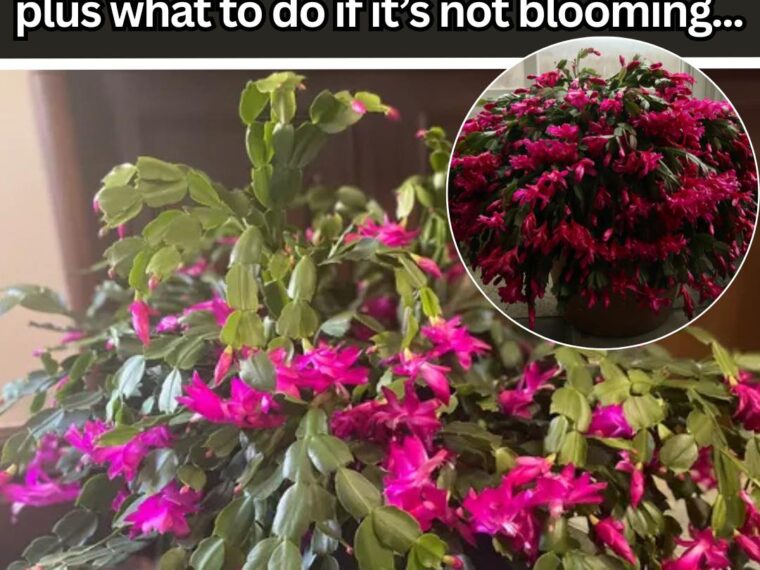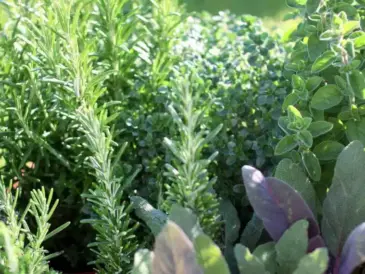Every year, as the days shorten and the air cools, one of the most beloved indoor plants begins to prepare for its annual show – the Thanksgiving cactus.
If cared for properly in November, this tropical beauty will burst into color just in time for the holidays, filling your home with bright pink, coral, red, or white blooms when most plants have gone dormant.
But here’s the secret that experienced growers know: November is the most important month for Thanksgiving cactus care.
Understanding the Thanksgiving Cactus (Schlumbergera truncata)
Before we jump into November care, let’s understand what makes the Thanksgiving cactus unique.
The Thanksgiving cactus (Schlumbergera truncata) is native to the tropical rainforests of Brazil – not deserts, as its name might suggest.
It grows in humid forests as an epiphyte, clinging to trees and rocks where it absorbs moisture and nutrients from decaying leaves and rainfall.
How to Identify It
Many people confuse Thanksgiving cactus with the Christmas cactus, but they’re slightly different:
| Feature | Thanksgiving Cactus (S. truncata) | Christmas Cactus (S. x buckleyi) |
|---|---|---|
| Stem Segments | Pointed, claw-shaped edges | Rounded, smooth edges |
| Bloom Time | Late November (Thanksgiving) | Late December (Christmas) |
| Flower Angle | Upright or horizontal | Drooping, bell-shaped |
| Flower Color | Red, pink, peach, orange, white | Mostly pink or red |
If your cactus starts setting buds in late October and blooms by late November, it’s almost certainly a Thanksgiving cactus.
Why November Is Their Time to Shine
In nature, Thanksgiving cacti bloom as the days shorten and nights grow longer – a natural cue called photoperiodism.
As daylight hours drop below 12 and temperatures cool slightly, the plant senses the change and begins producing flower buds.
This is why indoor conditions in November are so crucial: the right balance of light, temperature, and watering encourages buds to form. Too much light, warmth, or inconsistent watering during this time can halt blooming altogether.
In short – November is the “make-or-break” month for your cactus.
Part 1: Thanksgiving Cactus Care in November – Step-by-Step
Let’s break down the perfect November routine for your Thanksgiving cactus to ensure a spectacular holiday bloom.
1. Light: The Bloom Trigger
The Science
Thanksgiving cacti are short-day plants, meaning they need 12–14 hours of darkness every night to trigger bud formation.
If they’re exposed to artificial light after sunset (from lamps or TVs), the blooming process can be disrupted.
What to Do
- Place the plant in a room that receives bright, indirect light during the day and complete darkness at night.
- If possible, move it to a cool, north- or east-facing window during November.
- For those in colder climates, avoid windows with drafts – a consistent 60–65°F (15–18°C) is ideal.
Bloom Tip
If you can’t provide long nights naturally, simulate darkness by covering the plant with a box or lightproof cloth for 12–14 hours each evening for about 3 weeks.
2. Temperature: Cool Nights Encourage Buds
Temperature plays just as big a role as light in bloom development.
Ideal Range
- Daytime: 65–70°F (18–21°C)
- Nighttime: 55–60°F (13–16°C)
Cooler nights tell the plant that “winter” has arrived, initiating bud formation. But sudden cold drafts or frost can cause bud drop, so be gentle with temperature changes.
Avoid
- Placing the cactus near heating vents or radiators.
- Exposing it to cold windowsills or doors that open frequently.
3. Watering: Balanced, Not Dry or Soggy
One of the most common mistakes people make in November is overwatering or underwatering during the budding phase.
The Right Approach
- Keep the soil lightly moist – never saturated.
- Water only when the top inch of soil feels dry to the touch.
- Always drain excess water; these cacti hate sitting in soggy soil.
- Reduce watering slightly once buds appear – consistent moisture, not soaking wet soil, keeps buds from falling off.
Watering Trick
If your indoor air is dry, mist the plant lightly every few days to increase humidity without drenching the soil. Remember, they’re rainforest natives, not desert dwellers.
4. Humidity: The Hidden Factor in Bud Development
Thanksgiving cacti love humidity – around 50–60% is ideal. Dry indoor air (especially from heating systems) can make buds shrivel or fall before they open.
How to Increase Humidity Naturally
- Place the pot on a tray filled with pebbles and water (but keep the base above the waterline).
- Group your cactus with other plants to create a micro-humid environment.
- Occasionally mist the air around the plant using distilled or filtered water.
5. Feeding: Support the Buds, Then Pause
If your cactus is forming buds, light feeding can help it produce larger, more colorful flowers. But overfertilizing at this stage can stress the roots and cause bud drop.
Fertilizer Schedule
- Use a balanced, diluted houseplant fertilizer (10-10-10 or 20-20-20) once a month.
- Stop fertilizing once buds are fully formed – the plant doesn’t need extra nutrients during blooming.
- Resume light feeding after flowering ends, usually in January.
6. Soil: Well-Draining Mix Is Non-Negotiable
Thanksgiving cacti need air around their roots. A compact or soggy soil mix leads to root rot.
Best Soil Mix
- 2 parts high-quality potting mix
- 1 part orchid bark or pine bark fines
- 1 part perlite or coarse sand
This mimics their natural epiphytic growing conditions – loose, airy, and slightly acidic (pH 5.5–6.5).
Repotting Tip
If your plant hasn’t been repotted in 3 years, plan to do it after blooming season, around late winter or early spring. Never repot while buds are forming – they’ll drop instantly.
7. The Bud Stage: Handle With Care
Once buds appear (typically early to mid-November), treat your cactus like a sleeping baby – avoid moving it or changing its environment.
Why?
- Buds are sensitive to changes in light and temperature.
- Moving from one window to another can confuse the plant’s internal timer.
- Rotating or bumping the pot can cause buds to detach before opening.
Best Practice
Keep it in one stable spot with consistent light and moisture until blooming ends.
Part 2: Helping Your Thanksgiving Cactus Bloom Beautifully
If your cactus has formed buds, congratulations – the hard part is over! Now it’s all about helping those buds open into full, healthy flowers.
Here’s how to nurture the bloom phase through November and December.
1. Maintain Steady Conditions
Bud drop usually happens because of sudden changes. Keep:
- Temperature consistent between 60–70°F
- Light indirect but bright
- Soil evenly moist
Even one cold draft or night of dryness can make buds fall overnight.
2. Avoid Overhandling
Try not to move or rotate the plant once blooms are developing. Each bud or flower adjusts to light direction – rotating confuses it and can cause stress.
3. Remove Spent Blooms
After flowering, gently pinch off wilted blooms to encourage continued blooming and prevent energy waste.
4. Extend Bloom Life
You can prolong blooming by:
- Keeping the plant slightly cooler (60–65°F).
- Watering lightly and avoiding direct heat.
- Moving it out of harsh sunlight during the day.
Cooler, bright conditions help flowers last 4–6 weeks instead of fading quickly.
Part 3: Why Your Thanksgiving Cactus Isn’t Blooming
Nothing is more frustrating than a healthy, green cactus that refuses to bloom. If yours skips flowering or drops buds every year, don’t worry – the problem is fixable.
Here are the most common reasons your Thanksgiving cactus isn’t blooming, plus how to correct each one.
1. Too Much Light at Night
The #1 reason Thanksgiving cacti fail to bloom is exposure to light after sunset.
Even a small lamp or nearby television can interrupt the “long night” signal they need to form buds.
Solution:
- Give the plant 12–14 hours of uninterrupted darkness each night for 3–4 weeks in October and November.
- If your home lighting is unavoidable, cover the plant with a box or move it to a dark closet each evening.
2. Temperatures Are Too Warm
If nights stay above 70°F (21°C), the plant won’t trigger blooming.
Solution:
- Place in a room that stays between 55–65°F (13–18°C) at night.
- Avoid heaters, ovens, and vents.
Cool nights are the key to flower initiation.
3. Irregular Watering
Too much or too little water causes stress that prevents bud formation.
Solution:
- Water when the top inch of soil feels dry.
- Avoid standing water in saucers or jars.
- During bud formation, keep soil consistently moist but never soggy.
4. Poor or Compact Soil
If your soil is dense and old, roots can’t breathe – and stressed roots don’t produce blooms.
Solution:
- Repot after blooming using a loose cactus or orchid mix with perlite.
- Always use pots with drainage holes.
5. Overfertilizing
Excess nitrogen promotes leafy growth instead of flowers.
Solution:
- Stop feeding by late summer.
- Use a phosphorus-rich fertilizer (like 10-30-10) in early fall to promote budding.
6. Too Much Movement
Frequent moving or rotating during bud formation confuses the plant’s sense of light direction and causes buds to drop.
Solution: Keep the cactus in one location from October through December.
7. Low Humidity
Dry air from heaters or fireplaces can dry out buds before they open.
Solution:
- Mist regularly or use a humidity tray under the pot.
- Avoid placing near heating vents or fans.
8. Root-Bound or Stressed Plant
A pot that’s too small restricts growth and blooming potential.
Solution:
- Repot every 3 years after flowering.
- Use a slightly larger pot with fresh, well-draining soil.
9. Pests and Diseases
Mealybugs, scale insects, or fungal infections can weaken the plant, making it skip blooming.
Solution:
- Inspect leaves and soil monthly.
- Wipe pests with alcohol-soaked cotton or spray neem oil weekly until cleared.
10. Age or Recovery Period
Young plants (under 2 years) or those recovering from transplant shock may need a season or two before blooming consistently.
Solution: Stay patient. With consistent light and temperature care, it will bloom next year.
Part 4: After the Bloom – Post-Flowering Care
Once your cactus finishes blooming in December or January, it enters a rest period that sets the stage for next year’s show.
1. Reduce Watering
Water sparingly – once every 2–3 weeks. Allow the top soil to dry out completely before watering again.
2. Provide Bright, Indirect Light
Keep in a sunny window, but avoid direct midday sun, which can scorch leaves.
3. Allow a Short Dormancy
For 6–8 weeks, let the cactus rest in cooler conditions (55–60°F). This helps reset its internal clock for next year’s bloom.
4. Resume Feeding in Spring
When new growth appears in March or April, feed monthly with a balanced, diluted fertilizer (10-10-10).
Part 5: Troubleshooting Thanksgiving Cactus Problems
| Problem | Likely Cause | Fix |
|---|---|---|
| Buds falling off | Sudden temperature or light change | Keep environment stable |
| Leaves wrinkled or limp | Underwatering or root rot | Adjust watering schedule |
| Pale segments | Too much sunlight | Move to bright, indirect light |
| No new growth | Root-bound or nutrient-deficient | Repot and feed lightly in spring |
| Fungal spots | Overwatering or poor air circulation | Remove affected areas and use fungicidal spray |
Part 6: Fun Facts and Blooming Secrets
- Thanksgiving cacti are perennials: With good care, they can live and bloom for over 30 years.
- Each segment stores water: making them drought-resistant for short periods.
- Pollinator-friendly: In their native Brazil, hummingbirds pollinate their flowers.
- They bloom by the calendar: Adjusting light and temperature cues helps you predict flowering time almost to the week.
Part 7: The Perfect Blooming Environment Checklist (November Focus)
| Condition | Ideal Range | Why It Matters |
|---|---|---|
| Light | 8–10 hrs bright day / 14–16 hrs dark | Triggers bud formation |
| Temperature | 65°F day / 55°F night | Stimulates blooming hormones |
| Water | Moderate, consistent | Prevents bud drop |
| Humidity | 50–60% | Keeps buds hydrated |
| Fertilizer | None during bloom | Avoids bud stress |
| Air movement | Gentle, steady | Prevents mold and fungal spots |
Your Thanksgiving cactus has waited all year for this moment – and November is when its transformation truly begins.




